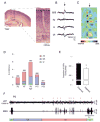Developmental appearance and disappearance of cortical events and oscillations in infant rats
- PMID: 20138849
- PMCID: PMC2848902
- DOI: 10.1016/j.brainres.2010.01.088
Developmental appearance and disappearance of cortical events and oscillations in infant rats
Abstract
Until recently, organized and state-dependent neocortical activity in infant rats was thought to commence with the emergence of delta waves at postnatal day (P)11. This view is changing with the discovery of several forms of cortical activity that are detectable soon after birth, including spindle bursts (SBs) and slow activity transients (SATs). Here we provide further evidence of surprisingly rich cortical activity patterns during early development and document, in P5-P13 rats, the appearance, disappearance, and transient expression of three cortical events and oscillations. EEG activity in frontal, parietal, and occipital cortices was recorded in unanesthetized, head-fixed subjects using 16-channel laminar silicon electrodes and Ag-AgCl electrodes. In addition to SATs, we identified two novel forms of activity: cortical sharp potentials (CSPs) and gamma bursts (GBs). SBs were not observed in these areas. CSPs, defined as discrete, biphasic events with a duration of 250 ms, exhibited an inverted-U developmental trajectory with peak prevalence at P9. In contrast, GBs, defined as brief bursts of 40-Hz activity, increased steadily in prevalence and duration from P5 through P13. The prevalence of SATs decreased steadily across the ages tested here. Furthermore, both CSPs and GBs were more likely to occur during sleep than during wakefulness. Because SATs, CSPs, and GBs exhibit different developmental trajectories and rates of occurrence, and can occur independently of each other, they appear to be distinct patterns of neuronal activity. We hypothesize that these diverse patterns of neurophysiological activity reflect the instantaneous local structure and connectivity of the developing neocortex.
Published by Elsevier B.V.
Figures





References
-
- Beierlein M, Gibson JR, Connors BW. A network of electrically coupled interneurons drives synchronized inhibition in neocortex. Nature Neuroscience. 2000;3:904–10. - PubMed
-
- Ben-Ari Y. Excitatory actions of GABA during development: The nature of the nurture. Nature Reviews Neuroscience. 2002;3:728–739. - PubMed
-
- Frank MG, Heller HC. Development of REM and slow wave sleep in the rat. American Journal of Physiology. 1997;272:R1792–R1799. - PubMed
-
- Gramsbergen A. The development of the EEG in the rat. Developmental Psychobiology. 1976;9:501–515. - PubMed
Publication types
MeSH terms
Grants and funding
LinkOut - more resources
Full Text Sources
Other Literature Sources
Miscellaneous

